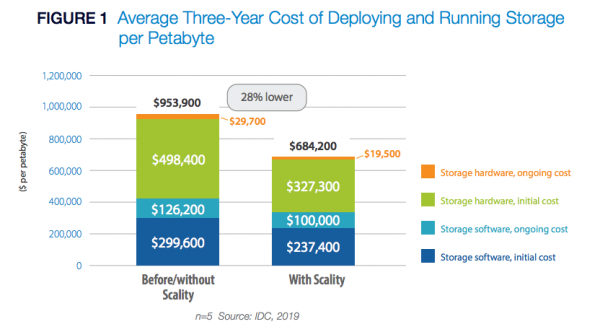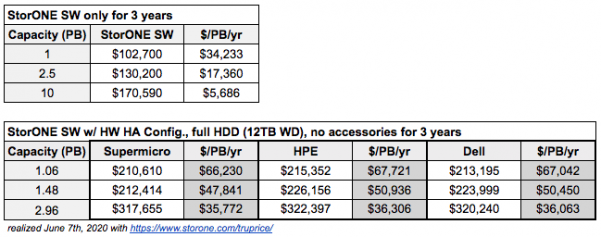Healthcare and Genomics IT Leaders Save Millions With Scality On-Prem SDS
Scale-out storage saving IT Pros $270,000/petabyte over 3 years and 46% less time managing storage infrastructure
This is a Press Release edited by StorageNewsletter.com on June 9, 2020 at 2:32 pmScality SA, reported how its RING brings efficiencies in modern healthcare and genomic data centers.
Over 40 global hospitals, hospital systems and genomics research institutions in the US, UK, Germany, France, Switzerland, Israel, Japan and South America have implemented RING. These customers trust the firm with their mission-critical diagnostic imaging data managed by leading PACS and VNA solutions, as well as key genomics data for use in development of new biopharmaceuticals. Many of these customers have experienced the ease of initial deployment and the scaling of RING with seamless capacity expansions to petabytes of storage.
IT leaders in these healthcare institutions share significant data growth challenges for radiological imaging, genomic sequencing, and other healthcare related services and applications. To modernize and address these challenges, they are now deploying scale-out SDS for on-premises private and hybrid cloud environments.
Respondents reported that scale-out storage deployments are 52% faster than traditional storage, require 46% less staff time managing the storage platform, and result in a 28% lower TCO (saving $270,000 per petabyte over 3 years). Expand these savings over 5 years and these IT leaders are saving millions of dollars in resource and capital expenditures with software defined storage solutions.
The IDC white paper, commissioned by the company, is available for download.
“The growing nature of data in the age of Covid-19 puts more pressure on the healthcare and genomics industries to modernize with cost-effective solutions,” said Amita Potnis, research director, IDC. “Our survey suggests that IT leaders who are required to build on-prem private or hybrid clouds, can rest a little easier with a cost-effective software defined, scale-out object storage solution like Scality offers.”
Click to enlarge
IT leaders at healthcare services and genomics research organizations, report their experience with RING object storage.
“The main operational benefit for us of Scality is the reduction of time required to operate, the time to deploy, and maintain the storage.”
“Scality does not require a lot of management effort, unlike a SAN. Scality has allowed us to consolidate our storage arrays, which reduced the heterogeneous systems to manage a unified backup system.”
“Scality…had the best ratio of cost per terabyte.”
Resources:
Report: The Business Value of Scality RING Scale-Out Storage for Healthcare Organizations
Blog: The explosion of healthcare data: How providers are managing growth without breaking the bank
Webinar: Healthcare & Genomics conversation with special guest Amita Potnis and Scality, host Paul Speciale on Tuesday, June 17, 9:00 a.m. Pacific Time.
Comments
Founded in 2009, Scality has finally found a new niche in medical environments where the product can be positively adopted. The company belongs to the challenger portion in the object storage market category according to the Map 2019 for Object Storage published by Coldago Research end of 2019.
This announcement promoted by a IDC sponsored report illustrates numbers from 4 medical entities in France and 1 from US. Note an error on page 5 table 1 as the total overall data environment should 4PB and not 4TB in the average column.
We understand that these customers have difficulties to adopt "traditional NFS" for obvious reasons as it is mentioned on page 7 but they probably didn't try any of these three NFS + S3 products such Pure Storage FlashBlade, Qumulo or VAST Data.
We learn on page 8 table 3 that the average data growth is only 13% at these medical environments, which is low and is a surprise.
What 's really interesting in this report is the savings shown i.e $270,000 globally from the TCO before/without and with Scality.

This report invites us to think about the real price for commercial storage software and especially its object flavor of it. I mean commercial to immediately evacuate open source, a real threat for object storage vendors and tough to beat, referring to a blog post written in October 2015.
How the result is articulated is a bit of a surprise. If we consider this logic over 5 years or 5 or 10PB, the number produced would have been bigger and would appeared more attractive. But we know that 5 years is not the right period to make good comparisons as support contracts cost very often more than 20% meaning that you pay double the software over 5 years so the logic of 3 years is preferred. But at the end of the day here it represents $90/TB/year (= $270,000/1,000/3) for the entire configuration. For information a Seagate Barracuda HDD of 1TB 2.5" SATA 5400 RPM costs just $49 on Amazon and a Western Digital Ultrastar 12TB 3.5" SATA 7200 RPM costs $330 on B&H.
Recently StorONE made a big splash with its online pricing simulator named TRUprice that finally shakes the storage industry and serves as a benchmark reference. You can test yourself the tool here for software only or associated with Supermicro, HPE and Dell hardware. Also StorONE develops and sells a multi-protocol SDS.
If we compare only initial cost, the figure 1 on page 10 of the report displayed above shows $237,400 for software acquisition. For StorONE, 1PB for 3 years costs $102,700 for software only so the ratio here is 2.3. The average configuration in the report indicates 2.8PB for the capacity used for file and object. Based on the table below for 2.5PB of StorONE software, it costs $130,000 for a ratio of 1.8.
OK, StorONE is a scale-up solution (scale-out is coming) but it helps to understand cost difference. All features are included even EC, infinite snapshot, replication, multi-protocol access: block, file and object. It's difficult to believe that cost difference comes from the scale-out capability and don't forget there is cost for server multiplication as well.
The 2 tables below show StorONE storage software only and with Supermicro, HPE and Dell hardware.











 Subscribe to our free daily newsletter
Subscribe to our free daily newsletter

